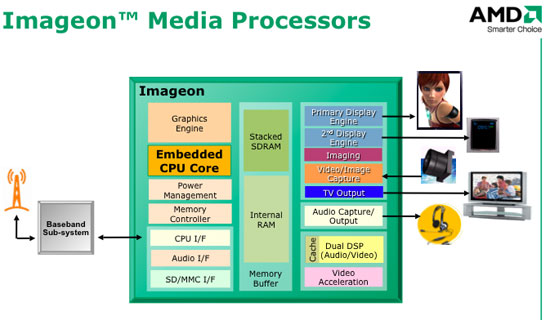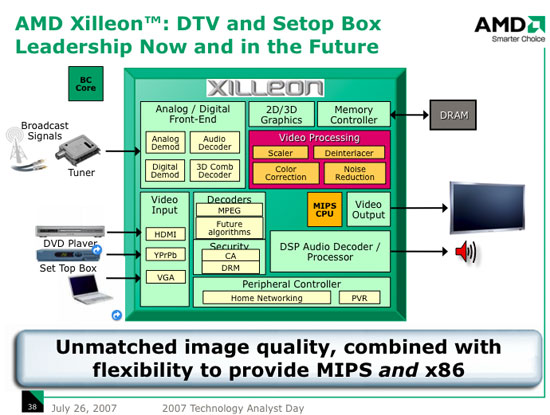Bobcat in your iPhone?
As much as everyone loves hearing about the iPhone every day, I must bother you with another reference - but I promise it has relevance.Apple made its transition to Intel x86 processors in record time, everything from its notebooks to its desktops and even the Apple TV use x86 processors. However, the iPhone uses an ARM based processor - which means Apple has to maintain compatibility with a completely different platform when adding OS X functionality to the iPhone. There's no doubt that Apple would prefer to have an x86 processor in its iPhone if for no reason than to simplify its software development, but neither Intel nor AMD make an x86 core that could work in such a cost/power sensitive device.
Intel is working on a chip that could be used in a device like the iPhone down the road, called Silverthorne. Silverthorne is the processor, Poulsbo is the chipset and the entire platform is called Menlow. It's due out in the first half of 2008 and it, like the Bobcat core, will be extremely simplified in order to work in these very low power, low cost devices.

AMD has a different approach; ATI had a number of consumer electronics customers prior to the acquisition, and it was already selling microprocessors into that space - although they were based on MIPS cores. AMD's Imageon and Xilleon processors have been used in set top boxes and digital TVs for a while now but after Bobcat is introduced, there will be a new option.

AMD will offer Imageon and Xilleon processors into the same markets it always has, but customers will be given the option of having a low powered x86 core instead of the ARM/MIPS solution they are used to, if they wish. AMD has to offer the option because it is already entrenched in the market, but the end goal is the same: to transition to x86 from top to bottom.
AMD insists that these new Imageon and Xilleon processors would roughly be the same size as present day ones, regardless of whether the customer chooses an x86 or non-x86 core. Only approximately 20% of the SoC (System on Chip) core is taken up by the x86 CPU, so the impact is minimal.
There's no doubt in our minds that devices like the iPhone will move to x86 based solutions, either from AMD with Bobcat or Intel with Silverthorne and its successors, in the coming years. Such a move would greatly simplify software development, as well as increase the capabilities of these devices.










31 Comments
View All Comments
flashbacck - Thursday, July 26, 2007 - link
Whoever decided those acronyms were necessary should be fired.fzkl - Thursday, July 26, 2007 - link
Like mentioned, the obvious great benefit of having low power x86 chips on mobile phones is the software aspect. PC applications can now run on phones reducing aspirin needs for developers. However, what does this mean in terms of security? Can we see mobile phones needing frequent patches, antivirus, firewalls like in the case of desktops?If this were to be the case we would have successfully made a simple device like the mobile phone(in usage terms) a high maintenance product which a layman might have trouble with.
sheh - Thursday, July 26, 2007 - link
x86 doesn't imply any OS or API. Linux, which is commonly used today on all kinds of devices, can work just as well on x86. Conversely, nothing prevents virus writers from writing viruses for Linux running phones.beyoku - Thursday, July 26, 2007 - link
what happened? Was this article recelty pulled off or something?NDA???
Guuts - Thursday, July 26, 2007 - link
Looks to me like he's trying to get the images working...erwos - Thursday, July 26, 2007 - link
Fusion looks like it'll be a fantastic chip for UMPCs and laptops. Hopefully they'll manage to squeeze more than CPU one core on there, too. Bobcat looks similarly fun - x86 phones! VIA was also discussing this idea, and I could really go for it.That said, AMD is really under-delivering with Barcelona - I suspect the next few years will be pretty rough. Intel has set a low ceiling price for the Barcelonas ($270 - same as the Q6600), and that's not going to be good for AMD's margins.
mlau - Thursday, July 26, 2007 - link
Embedded is ruled by ARM, Freescale, mips and sh derivates; amd and intel are going to have a tough time getting a super-ugly system like pc-x86 (with it's
legacy baggages "bios", "acpi" [you know, the stuff windows requires to run], ...) into that space.
Spoelie - Friday, July 27, 2007 - link
you do not need to have those things to run an x86 cpuloot at EFI for example, in use by apple on their x86 based macs = no more bios.
qpwoei - Sunday, July 29, 2007 - link
The real problem with x86 is that it's inherently not power efficient. To get good x86 performance requires lots of transistors and lots of power due to complex decoders and schedulers. A much simpler architecture like ARM requires very few transistors to run efficiently (at the expense of slightly less compact executable code), and is much more suited for battery-powered devices.Not to say that there won't be x86-powered devices in the future, just that I don't expect them to really gain much of a foothold in any place where battery life is important (eg: phones).
ss284 - Thursday, July 26, 2007 - link
Return of the Jedi